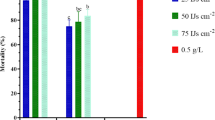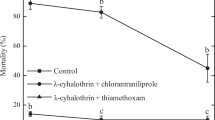Abstract
Relative susceptibility of laboratory-established cultures of four populations of Dysdercus fasciatus Sign. and one population each of D. nigrofasciatus Stal., D. cardinalis Gerst. and D. superstitiosus (F.) to topical applications of Cypermethrin, fenvalerate and permethrin was investigated at Kibos, Kenya. The LD50 values of the three chemicals to populations of D. fasciatus were 0.0656-0.0757, 0.335-0.469, 0.442-0.505 µg/insect, respectively, while those for D. nigrofasciatus were 0.1690-0.2541, 0.481-0.504, 0.721-0.851 µg/insect. The LD50 values for D. cardinalis and D. superstitiosus were 0.1507, 0.714, 0.798 µg/insect and 0.0991 and 0.824 µg/insect of each of the three chemicals respectively. Based on D. fasciatus from Kibos as the reference strain, the relative susceptibility values of all populations of Dysdercus species studied were small (< four-fold) indicating that resistance was not apparent in the cotton stainers. Of the three insecticides tested, Cypermethrin was the most effective judging from the high toxicity ratios between it, fenvalerate and permethrin.
Résumé
Des études ont été menées sur la sensibilité aux 3 pyrethrinoïdes (Cypermethrin, fenvalerate et permethrin) de 4 espèces de Dysdercus (D. fasciatus Sign., D. nigrofasciatus Stal., D. cardinalis Gerst. et D. superstitiosus [F.]) venant de Kenya, en utilisant des colonies d’insectes établies au laboratoire. L’étude de la mortalité, basée sur l’action de contact, a porté sur les nymphes femelles du cinquième stade, âgées de cinq à six jours. Les résultats ont montré que les pyrethrinoïdes de synthèse sont efficaces contre Dysdercus spp. Les LD50 de Cypermethrin, fenvalerate et permethrin sont respectivement 0.0656-0.0757, 0.335-0.469 et 0.442-0.505 mg/ml pour D. fasciatus, 0.1690-0.2541, 0.481-0.504 et 0.721-0.851 mg/ml pour D. nigrofasciatus, et 0.1507, 0.714 et 0.798 mg/ml pour D. cardinalis. Cepandant pour D. superstitiosus le DL50 de Cypermethrin est 0.0991-0.824 mg/ml. Les résultats ont montrés que l’espèce D. fasciatus est la plus sensible aux trois produits. Parmi les insecticides testés, Cypermethrin est le plus efficace alors que les fenvalerate et permethrin montrent leur efficacité dans l’ordre décroissant.
Similar content being viewed by others
References
Anonymous (1978) Annual report, 1978 crop season. Cotton Research Station Kibos, Kenya Ministry of Agriculture.
Anonymous (1984) Annual report, 1984 crop season. Cotton Research Station Kibos, Kenya Ministry of Agriculture.
Busvine J. R. (1971) A Critical Review of the Techniques for Testing Insecticides. Commonwealth Institute of Entomology, London.
FAO (1969) FAO International collaborative programme for the development of Standard Tests for Resistance of Agricultural Pests to Pesticides. Plant Prot. Bull. 17(4).
La Croix E. A. S. (1966) Stainer bugs (Dysdercus spp.) in Coast Province, Kenya. Emp. Cott. Grow. Rev. 43, 41–45.
Nyamasyo G. H. N. and Karel A. K. (1982) Studies on insecticide resistance in cotton stainers, Dysdercus spp. (Hemiptera: Pyrrhocoridae) in Kenya. Bull. ent. Res. 72, 461–465.
Pearson E. O. and Maxwell D. R. C. (1958) The Insect Pests of Cotton in Tropical Africa. Cotton Research Corporation and Commonwealth Institute of Entomology, London.
Potter C., Tattersfield F. and Gillham E. M. (1947) A laboratory comparison of the toxicity as a contact poison of DDT with nicotine derris products and the Pyrethrins. Bull. ent. Res. 37, 469–495.
Sawicki R. M. (1979) Resistance to pesticides: I. Resistance of insects to insecticides. Span 22, 50–52.
Tengecho B. (1984) The biological performance of Dysdercus cardinalis Gerst. and D. fasciatus Sign. on five different host plants. M. Sc. Thesis. University of Nairobi.
Author information
Authors and Affiliations
Rights and permissions
About this article
Cite this article
Mambiri, A.M., Khaemba, B.M. Susceptibility of Dysdercus species Boisduval (Hemiptera: Pyrrhocoridae) to Selected Synthetic Pyrethroids. Int J Trop Insect Sci 9, 309–312 (1988). https://doi.org/10.1017/S1742758400006251
Received:
Revised:
Published:
Issue Date:
DOI: https://doi.org/10.1017/S1742758400006251




